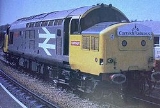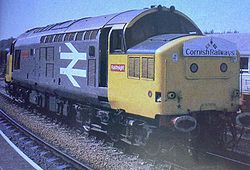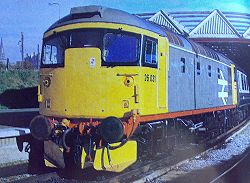
Railfreight
Encyclopedia


British Rail
British Railways , which from 1965 traded as British Rail, was the operator of most of the rail transport in Great Britain between 1948 and 1997. It was formed from the nationalisation of the "Big Four" British railway companies and lasted until the gradual privatisation of British Rail, in stages...
responsible for all freight operations on the British network. The division was created in 1982 when BR sought to assign particular stock and management to the evolving requirements of freight traffic. It existed as a single unit until 1987 when BR freight operations were further divided according to type of material carried, and the Trainload Freight
Trainload Freight
Trainload Freight was the sector of British Rail responsible for trainload freight services. It was formed in 1987 as a further development of the single Railfreight division created by BR in 1982, and existed until the onset of privatisation in 1994. The sector was subdivided according to the...
subsectors and Railfreight Distribution
Railfreight Distribution
Railfreight Distribution was a subsector of British Rail created by the division in 1987 of British Rail's previous Railfreight sector. It was responsible for non-trainload freight operations, as well as Freightliner and Intermodal services. In its early years the division was occasionally...
were introduced. Activities which were not assigned to one of the new Trainload Freight or Railfreight Distribution subsectors were then continued under the Railfreight General banner.
Livery
The Railfreight sector was immediately identifiable through the introduction of a new 'Railfreight Grey' livery, originally created for the new Class 58British Rail Class 58
The British Rail Class 58 is a class of Co-Co diesel locomotive designed for heavy freight. Introduced in 1983, they followed American practice of modularisation. From new they were painted in grey Railfreight Sector livery, instead of BR blue...
locomotives which began to appear in 1982, and then soon applied to most of the locomotives and rolling stock assigned to the division. This new colour scheme was very distinctive on the British network as it represented the first clear break from the universal application of variations of Rail Blue
British Rail corporate liveries
The history of British Rail's corporate liveries is quite complex. Although from the mid 1960s to the 1980s the company was associated with "Rail Blue", a number of other schemes were also used, especially when the company was sectorised in the 1980s....
for 15 years. The new livery was further distinguished, in locomotive classes such as the Class 58, Class 20
British Rail Class 20
The British Rail Class 20, otherwise known as an English Electric Type 1, is a class of diesel-electric locomotive. In total, 228 locomotives in the class were built by English Electric between 1957 and 1968, the large number being in part because of the failure of other early designs in the same...
and Class 26
British Rail Class 25
The British Rail Class 25 diesel locomotives were also known as Sulzer Type 2 and nicknamed Rats, as it was alleged they could be seen everywhere in Britain, and hence were "as common as rats"...
where the bodywork was mounted on a solebar, by painting the solebar red to give a distinctive red stripe running the length of the lower bodyside, a livery known as 'Railfreight Red Stripe'. Other classes of locomotives with an integrated monocoque
Monocoque
Monocoque is a construction technique that supports structural load by using an object's external skin, as opposed to using an internal frame or truss that is then covered with a non-load-bearing skin or coachwork...
construction and so no solebar, such as the Class 37
British Rail Class 37
The British Rail Class 37 is a diesel-electric locomotive. Also known as the English Electric Type 3, the Class was ordered as part of the British Rail modernisation plan....
, Class 47
British Rail Class 47
The British Rail Class 47, is a class of British railway diesel-electric locomotive that was developed in the 1960s by Brush Traction. A total of 512 Class 47s were built at Crewe Works and Brush's Falcon Works, Loughborough between 1962 and 1968, which made them the most numerous class of British...
and Class 56
British Rail Class 56
The British Rail Class 56 is a type of diesel locomotive designed for heavy freight work. It is a Type 5 locomotive, with a Ruston-Paxman power unit developing 3,250 bhp , and has a Co-Co wheel arrangement...
, merely had red buffer beams.
Some of the monocoque locomotives briefly acquired a red stripe in 1987; however following the creation of Trainload Freight and Railfreight Distribution in 1987, they were soon repainted in the new subsector two-tone grey livery with appropriate decals. Four remaining Railfreight locomotives and rolling stock, not assigned to subsectors, were painted in two-tone grey livery with dedicated Railfreight General decals. Railfreight General was dissolved in 1989, its limited responsibilities taken over by Railfreight Distribution.

